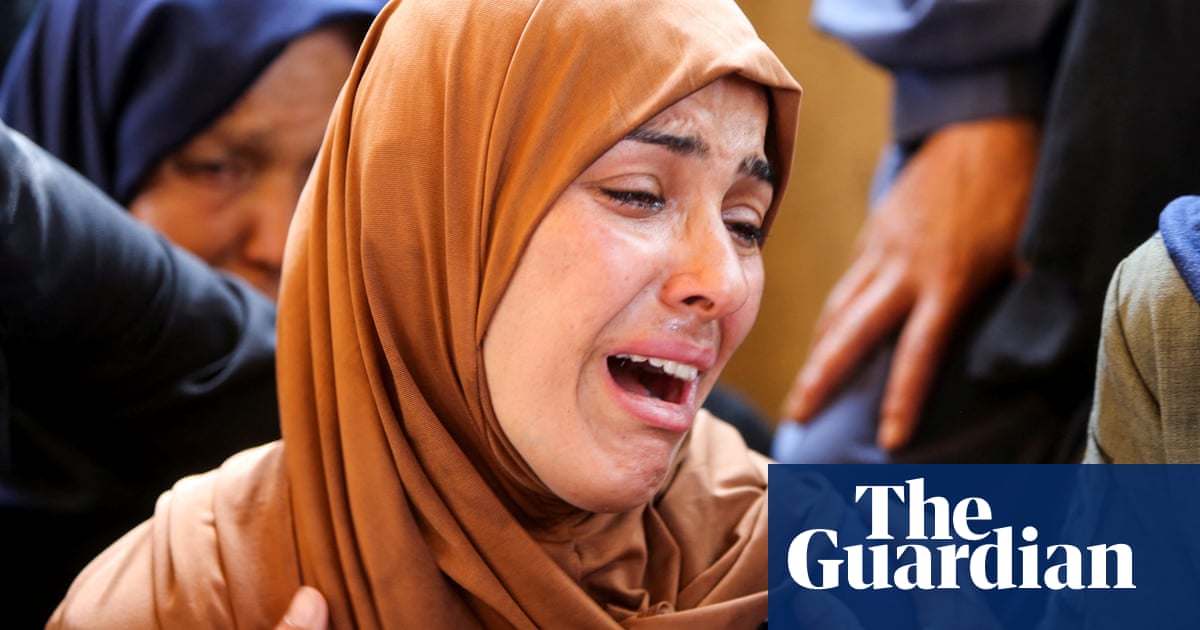At least five people have been killed and others wounded by Israeli fire about a kilometre from a food distribution point in Gaza, Palestinian health officials and witnesses said.
Palestinian witnesses said Israeli forces had opened fire on Sunday morning as people went to receive supplies from a site in Rafah run by theGazaHumanitarian Foundation (GHF), an Israeli- and US-backed group.
Israel’s military said it had fired warning shots at people who had approached its forces. It acknowledged reports of injuries but did not specify how many people it believed had been affected.
Bodies were brought to Nasser hospital in Khan Younis, which confirmed the death toll. Al-Awda hospital said it had received the body of a 42-year-old man, as well as 29 people who had been wounded near another GHF distribution point.
The deaths bring the number of people who have been killed while trying to find food in Gaza since 27 May, when GHF became responsible for civilian food provision, to 110. More than 1,000 have been injured.
Witnesses said Sunday’s shooting in southern Gaza occurred at about 6am, when they had been told the site would open. Many had headed towards it early to try to get desperately needed food before the crowds. The military had announced on Friday that the sites would be open from 6am and that the area would be a closed military zone from 6pm until 6am.
A GHF spokesperson said there had been “no incident at or in [the] surrounding vicinity” of any distribution site.
Adham Dahman, 30, who was at Nasser hospital with a bandage on his chin, told Associated Press that a tank had fired in their direction. “We didn’t know how to escape,” he said. “This is trap for us, not aid.”
Zahed Ben Hassan, another witness, said someone next to him had been shot in the head. He said he and others had pulled the body from the scene and managed to flee to the hospital.
“They said it was a safe area from 6am until 6pm … so why did they start shooting at us?” he said. “There was light out, and they have their cameras and can clearly see us.”
Sanaa Doghmah told Reuters that her husband, Khaled, 36, was fatally shot in the head while trying to reach a distribution site in Rafah to collect food for their five children.
Khaled’s aunt, Salwah, said at his funeral: “He was going to get food for his children and himself, to make them live, feed them, because they don’t have a pinch of flour at home.”
There have been frequent shootings in the past two weeks near the new hubs, where thousands of Palestinians are being directed to collect food.
The GHF announced on Wednesday that its operations would be suspended for 24 hours after Israeli troops opened fire on a crowd of Palestinians, as it pressed Israel to improve civilian safety beyond the perimeter of its distribution sites.
Israeli troopskilled at least 27people and injured hundreds on Tuesday far beyond the perimeter of the distribution sites. They denied firing at civilians, but an Israel Defense Forces official admitted soldiers had fired “warning shots toward several suspects who advanced toward the troops” near the food distribution site, without specifying who the suspects were.
On 1 June, 31 Palestinians were killed by Israeli fire as they went to receive food. Israel said it had fired warning shots towards several suspects who advanced towards troops.
Israelimposed a blockade on all suppliesto Gaza in March, saying Hamas was seizing deliveries for its fighters, which the group denies. A global hunger monitor said in May that half a million people in the strip faced starvation. TheIPC estimatedthat nearly 71,000 children under five were expected to be “acutely malnourished”, with 14,100 cases expected to be severe in the next 11 months.
The hubs are set up inside Israeli military zones, to which independent media have no access, and are run by GHF, a new group of mainly US contractors. Israel wants it to replace a system coordinated by the UN and international aid groups.
The UN and other humanitarian organisations have rejected the new system, saying the GHF will not be able to meet the needs of Gaza’s 2.3 million people and that it allows Israel to use food as a weapon to control the population.
Associated Press and Reuters contributed to this report
